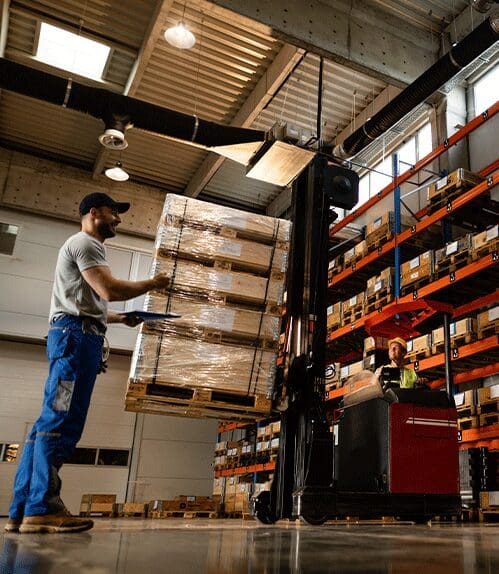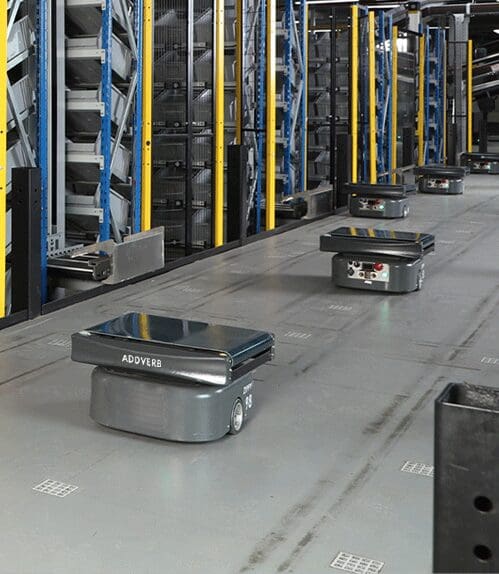Table of Contents
In today’s competitive business landscape, companies are recognizing that efficient warehouse operations are crucial for customer satisfaction and cost reduction. As a result, warehouse automation is no longer a luxury but a necessity, driving its continued growth and significance in 2025 and beyond.
Warehouse automation is the use of technology and robotics in logistics to streamline and optimise various tasks within a warehouse, such as inventory management, material movement, picking, and sortation. In 2025, warehouse automation has gained unprecedented significance in the world of supply chain management.
The growing importance of automation in supply chain management can be attributed to several factors and benefits of automation, we will take you through each of the factors and their imporatance in this article.
Why do we really need Warehouse Automation now?
1. Improved Efficiency
Automation enhances warehouse efficiency by employing technologies like Autonomous Mobile Robots (AMRs) for optimised material movement, Automated Guided Vehicles (AGVs) for precise sortation, Automated Storage and Retrieval System for dense storage, and Pick-to-Light systems for accurate picking. AMRs navigate efficiently, reducing travel times, and ensuring continuous operation. AGVs automate sorting, reducing errors, and improving order fulfilment rate. Pick-to-Light systems provide visual guidance, minimising picking time and errors while offering real-time inventory updates. These technologies collectively reduce labour costs, increase accuracy, and expedite operations, enabling warehouses to become more efficient.
2. Enhanced Accuracy
Automation enhances the accuracy of warehouse operations through precise and consistent execution of tasks. Automated systems use advanced technologies like barcode scanners, RFID tags, and computer vision to minimise human error in tasks like picking, packing, and inventory management. They ensure items are placed in the correct locations and accurately recorded, reducing the risk of misplacements or miscounts. Additionally, automated processes can cross-verify data in real-time, preventing discrepancies. By eliminating manual data entry and repetitive tasks, automation minimises the potential for mistakes, resulting in higher accuracy levels in the warehouse.
3. Scalability
Warehouse automation contributes to scalability by increasing efficiency and reducing labour costs. Automated systems like robots, conveyor belts, and AI-driven inventory management optimise processes, allowing companies to handle higher volumes of goods without proportional increases in labour. This scalability enables businesses to respond quickly to market demand fluctuations and seasonal peaks. Additionally, automation improves accuracy, reduces errors, and minimises downtime, enhancing overall operational reliability. As a result, companies can expand their operations and adapt to changing customer demands more effectively, ultimately leading to flexibility and scalability of operations.
4. Real-time Visibility
Automated systems continuously collect and transmit data on inventory levels, order status, equipment performance, and personnel productivity. This information is processed in real-time, providing managers with up-to-the-minute insights into warehouse activities. Automated material handling and robotics in logistics enable precise tracking of inventory movement, reducing errors and delays. Moreover, data-driven algorithms optimise workflows, ensuring efficient resource allocation. As a result, warehouse automation empowers organisations to make informed decisions, streamline operations, and respond swiftly to changes, ultimately improving overall visibility in the supply chain.
5. Inventory Optimisation
Warehouse automation contributes to inventory optimisation by improving accuracy, efficiency, and visibility in inventory management. Automated systems, such as robotic pickers and RFID technology, reduce human errors, ensuring precise stock levels. Automated data collection and analysis enhance real-time tracking of inventory, helping in demand forecasting and reducing overstock or stockouts. Additionally, automation allows for dynamic slotting and intelligent routing of items, maximising space utilisation and minimising travel time. These benefits collectively lead to reduced carrying costs, improved order fulfilment, and better overall inventory control.
6. Increased Productivity
Warehouse automation enhances productivity by reducing labour costs, minimising errors, and optimising processes. Automated systems, like conveyor belts, robots, and automated guided vehicles (AGVs), streamline tasks such as picking, packing, and sorting. They work tirelessly without breaks, increasing throughput and efficiency. Automation results in faster order fulfilment, reduced operational costs, and improved customer satisfaction, making it a crucial factor in boosting warehouse productivity.
15 Unique types of Conveyor Systems – Also Read
7. Customer Satisfaction
Warehouse automation contributes to increased customer satisfaction by enhancing the efficiency and accuracy of order fulfilment processes. Automated systems can pick, pack, and ship orders faster and with fewer errors, leading to quicker deliveries and reduced order inaccuracies. This improves order reliability and ensures that customers receive their products on time and in the right condition. Additionally, automation enables better inventory management, reducing stockouts and overstock situations, which can frustrate customers. Overall, these benefits of automation result in a more seamless and reliable shopping experience, ultimately boosting customer satisfaction and loyalty.
8. Sustainability
Warehouse automation enhances sustainability by minimising energy consumption through efficient equipment usage and optimising space utilization. Automated systems streamline inventory management, reducing overstocking and waste. They enable precise demand forecasting, minimising the need for rush deliveries and excess packaging. Additionally, automation promotes a cleaner, safer work environment, enhancing employee well-being. By curbing resource consumption, lowering emissions, and promoting eco-friendly practices, automation plays a pivotal role in sustainable operations, aligning with environmental and economic goals.
9. Enhanced Safety
Automation enhances safety by reducing the need for manual labour in potentially hazardous tasks. Automated systems, such as AMRs and conveyors, minimise the risk of accidents related to heavy lifting and repetitive motions. Additionally, automation ensures consistent and precise handling of goods, reducing the likelihood of damaged products and associated safety hazards. Warehouse automation promotes a safer work environment by minimising physical strain, errors, and accidents associated with manual labour.
10. Faster Order Fulfilment
Warehouse automation significantly speeds up order fulfilment by replacing manual labour with efficient, automated processes. Automated systems, such as robots and conveyors, can swiftly locate and transport items to packing stations, reducing the time spent searching for products. Additionally, automation improves inventory management accuracy, preventing delays caused by stockouts or misplacements. Advanced software and algorithms optimise order picking routes, minimising travel time. Moreover, automation operates 24/7, ensuring round-the-clock order processing. Overall, the reduction in human error, increased efficiency, and continuous operation in warehouse automation all combine to significantly accelerate order fulfilment, leading to faster delivery times for customers.
Growing Trends and Strategies in Omnichannel Fulfilment – Also Read
11. Reduced Down Time
Warehouse automation reduces downtime by optimising inventory management, expediting order processing, minimising human errors, enabling predictive maintenance, optimising routing, allowing for 24/7 operations, and providing valuable data analytics. Automated systems ensure inventory accuracy, streamline order fulfilment, and prevent errors, reducing downtime spent on error correction and stock replenishment. Predictive maintenance prevents unexpected equipment failures, and optimised routing ensures efficient product movement. The ability to operate continuously enhances productivity further, and data analytics enable proactive issue resolution, all contributing to a significant reduction in downtime, ultimately increasing warehouse efficiency and throughput.
12. Cost Savings
Warehouse automation contributes to cost savings in several ways. Firstly, it reduces labour costs by replacing manual tasks with automated systems like robots and Automated Storage and Retrieval Systems(ASRS), which work efficiently and consistently without breaks. This leads to lower payroll expenses and decreases the risk of errors associated with human labour.
Secondly, automation through ASRS optimises space utilisation. Automated systems can stack items more densely, making the most of available warehouse space and potentially reducing the need for larger facilities, which can be a substantial cost-saving.
Moreover, automation enhances inventory management by providing real-time data on stock levels and movements, reducing overstocking and stockouts. This improves working capital management and minimises the costs associated with excess inventory and lost sales.
13. Competitive Advantage
Automation contributes to competitive advantage by enhancing operational efficiency, reducing labour costs, and minimising errors. Automated systems can process orders faster, leading to shorter delivery times and improved customer satisfaction. They also enable better inventory management, reducing carrying costs and stockouts. Additionally, automation allows for data-driven decision-making, optimising resource allocation and order fulfilment strategies. This agility and cost-effectiveness give companies a competitive edge in today’s fast-paced business environment, enabling them to meet customer demands more effectively, offer competitive pricing, and ultimately achieve higher profitability.
Talk to us to know more how Addverb can change your business
It is High Time for Warehouse Automation
The future of warehouse automation in 2025 is poised for a remarkable transformation, fuelled by a convergence of emerging technologies and advancements that promise to reshape the industry of Supply chain management. One of the standout trends is the proliferation of robotics in logistics, with autonohttps://addverb.com/role-of-technology-in-supply-chain-management/mous mobile robots (AMRs) and collaborative robots (cobots) evolving into sophisticated workhorses within warehouse environments. These robots are now capable of executing an array of tasks, ranging from material movement and sorting to order picking and packing, effectively boosting operational efficiency while significantly reducing labour costs.
Furthermore, the integration of artificial intelligence (AI) and machine learning has reached new heights. These advanced algorithms are being harnessed to optimise nearly every facet of warehouse operations. They empower businesses with predictive analytics and demand forecasting capabilities, enabling precise inventory management. By ensuring that the right products are stocked in the right quantities at the right time, AI-driven systems mitigate excess inventory costs and prevent costly stockouts, thereby enhancing overall supply chain efficiency.
In an era marked by digital acceleration and heightened customer expectations, embracing these transformative technologies is not merely a strategic move but an imperative one. Warehouses that invest in automation stand to gain higher productivity, lower operational costs, and improved customer satisfaction, thus positioning themselves for enduring success in a dynamic and competitive market landscape.





